Wish of Hiroshima
After the occupation-period press code regulating speech and writing was canceled with the signing of the San Francisco Peace Treaty in September 1951, entering into force in April 1952, people were able to freely express their opinions about the A-bombing not only in press coverage but also in artistic activities. In March 1954, the tuna fishing vessel Fukuryu-maru No. 5 (Lucky Dragon), which had been operating off the coast of the Bikini Atoll, was exposed to radioactive fallout from a hydrogen bomb test by the United States. Triggered by this incident, calls for a ban on atomic and hydrogen bombs were made all over Japan, with growing concerns for A-bomb damage in Hiroshima and Nagasaki.
Expanding Movement
Works that describe the calamity caused by the A-bombing and suffering of the A-bomb survivors were presented one after another through diverse media, including not only poems and novels but also paintings, theatrical plays and movies. Signature-collecting campaigns calling for a ban on atomic and hydrogen bombs were active all over Japan. In Hiroshima, new campaigns began, such as a sit-in to protest against nuclear tests. Meanwhile, around August 6, groups holding placards against war and nuclear weapons assembled from all over Japan in the neighborhood of the Peace Memorial Park, and held a demonstration. Some A-bomb survivors were bewildered by the demonstration’s seething atmosphere.
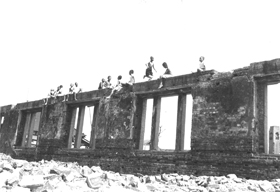 |
Shooting of the movie “Children of Hiroshima”1952 Ote-machi 1-chomeLocation shooting for the movie, “Children of Hiroshima,” was conducted in Hiroshima City. Children who acted in this movie are seen on the top of the wall around the A-bomb Dome. |
|||
A sit-in in front of the Cenotaph for the A-bomb Victims (Right)1957 Nakajima-choThe first sit-in protest against the UK’s nuclear test plan on Christmas Island was held in front of the Cenotaph for the A-bomb Victims. The four seated participants never turned their backs to the cenotaph. |
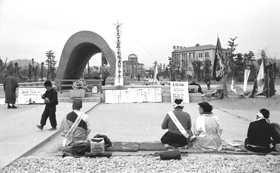 |
|||
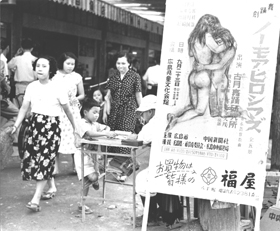 |
Presenting a dance play “No More Hiroshimas” (Left)1952 HatchoboriA poster for a dance drama, “No More Hiroshimas,” displayed in a shopping street. Many performances on the theme of the A-bombing were presented, such as original ballets, Japanese dance and theatrical plays. |
|||
Unveiling ceremony of the Children’s Peace Monument (Right)1958 Nakajima-choFor the construction of the Children’s Peace Monument, contributions were collected from more than 3,000 schools in Japan and also overseas. On Children’s Day, May 5 in 1958, the unveiling ceremony of this monument was conducted. |
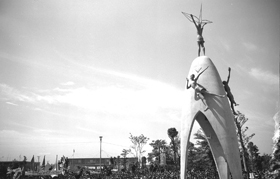 |
|||
 |
Demonstrators flocking to the Peace Memorial Park (Left)1971 Nakajima-choClosely connected with labor movements and student movements at a time of rising political conflict, campaigns against atomic and hydrogen bombs gradually intensified. There were moments around August 6 when roars of anger filled the Peace Memorial Park. |
|||
Quiet Prayers
Every August 6, the Peace Memorial Park is filled with prayers from dawn to midnight for the souls of deceased victims. On that day, people can be seen offering flowers and putting their hands together in prayer at corners of buildings throughout the downtown area. These are not events that happen only on August 6, however. There seems to be no end to people visiting the Cenotaph and Memorial Mound, despite blazing sunlight or blinding snow. The point of departure for the spirit of Hiroshima lies in these quiet prayers.
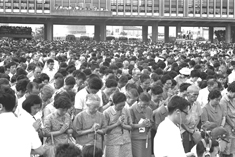 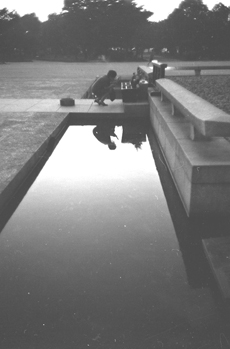 
In the snow1967 Nakajima-choThese people visited the Cenotaph for the A-bomb Victims during a snowstorm. |
Early morning on August 6 (Left)1965 Nakajima-choAt the crack of dawn, people begin to offer flowers, joining their palms in prayer at the Cenotaph for the A-bomb Victims. This is the start of the day of prayers in Hiroshima.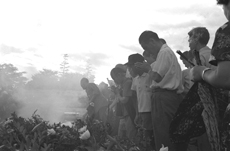 August 6 at 8:15 a.m.1965 Nakajima-choParticipants in the Peace Memorial Ceremony offer silent prayers at the sound of the Peace Bell at 8:15 a.m., the time of the A-bombing. Several foreigners can be seen in this photograph.Cenotaph for the A-bomb Victims at dusk (Left)1968 Nakajima-choAfter sunset, few visitors are seen in the Peace Memorial Park. Quiet prayers are offered to the spirits at the Cenotaph for the A-bomb Victims.
In front of the Hiroshima Bankers Association (the former Hiroshima Bankers’ Club)1970 Ote-machi 2-chomeVisiting this site on August 6 of every year, this woman offers flowers at the entrance of the building where her daughter died, quietly joining her palms in prayer. |
